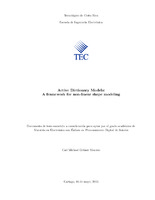Active dictionary models: A framework for non-linear shape modeling
Resumen
Shape modeling has applications in science and industry fields. The existing algorithms
are based on linear methods and on unimodal normal distributions not appropriate to
model deformations present in natural signals. This work presents a novel shape model
based on dictionary learning which is capable of representing these deformations.
First a dictionary is trained through K-SVD and OMP. Then it is used as a model to
represent shapes using a sparse weighting vector. The denoising properties of the model
are shown for additive noise, but with the limitation that it can also represent invalid
shapes.
Afterwards, in order to compensate for the dictionary model limitation, a non-linear
denoising method is developed based on orthogonal manifold projections. This extension
ensures that the output is always a valid shape.
Finally the complete iterative algorithm is presented. In this stage, the application o↵ers
an initial approximation of the shape to segment. The shape is modeled using the dictionary
and projected to the manifold whereby a valid shape is ensured. This process is
repeated until an established convergence criteria is met. It is shown how the proposed
method is capable of modeling both linear and non-linear deformations with high success.
Descripción
Proyecto de Graduación (Maestría en Electrónica) Instituto Tecnológico de Costa Rica, Escuela de Ingeniería Electrónica, 2015.


